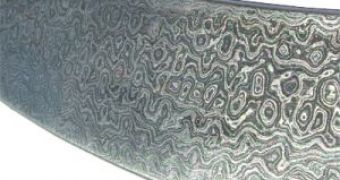Studying medieval Damascus swords, researchers found that Medieval smiths used, maybe for the first time, what we call today nanotechnology: the steel of the legendary blades embarks in its structure cementite (iron carbide) nanowires, carbon nanotubes, and other extremely small, intricate structures that might explain the unusual hardness, sharpness and banding of the blade.
Carbon nanotubes have been understood and produced by scientists only in the last decades and today, they are included in the composition of artificial materials tougher than anything occurring in nature. Damascus swords were first made in the eighth century A.D. But the technique was lost in the seventeenth century. The material got near-mythical status and legend says that the blades can cut apart a piece of silk as it falls to the ground and keep their edge sharp after cutting through stone, metal, or even other swords.
A team at Technical University in Dresden, Germany had discovered the tiny nanowires and nanotubes in a 17th blade using an electron microscope. "The carbon nanotubes in the sword are the first nanotubes ever found in steel", said Peter Paufler, a crystallographer. The nanotubes, extremely strong, greatly strengthen the blade's softer steel. "Materials that are softer, you can strengthen by including harder wires."
Most nanowires were made of cementite, a very hard iron-based mineral. New research has found that carbon nanotubes wrap many cementite nanowires confering them protection. "These nanotube-nanowire bundles may give the swords their special properties", Paufler says.
The bundles setup cementite in hard layers, inside the softer steel, and so the material is strong yet flexible. Metal ingots made in India, called wootz, contained probably the right carbon amount and other impurities, but the detailed forging process was never written down.
When the blades were almost finished, blacksmiths etched them using acid, forming models of light and dark lines, very characteristic to Damascus swords. "But it could also give the swords their sharpness," Paufler says.
During acidification, carbon nanotubes, which are non-attackable by the acid, protected the nanowires. After that, many nanostructures could stick out from the blade's edge, which got an irregular edge.
The researchers want to recreate the Damascus steel. However, even if exceptional for its time, is far outperformed by modern steels. However, many doubt that the recreations are truly the same as the originals. "I don't think that [the nanowires] are anything unusual," said John Verhoeven, a metallurgist at Iowa State University at Ames who realized some replicas.
"I think those structures would be found in normal steels."
Even so, the Damascus steel shows us how unexpected nanomaterials can be found in ancient materials, explaining their awesome properties.

 14 DAY TRIAL //
14 DAY TRIAL // 
